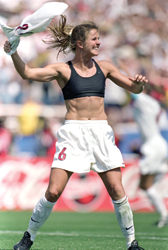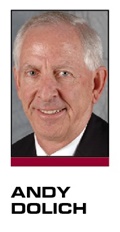There was a small obituary in sports sections on May 19, 2012, announcing the final kick of Women’s Professional Soccer. The league had canceled the 2012 season in January, hoping to return in 2013. The season was scrapped amid a nasty lawsuit between the owner of the South Florida franchise and WPS officials.
The Women’s United Soccer Association also failed, lasting only three seasons and burning through a mountain of cash after the euphoria of the U.S. victory at the 1999 World Cup.
Ever since Brandi Chastain made sports bras a multimillion-dollar business with her shot heard round the globe at the heart-pounding conclusion of the 1999 Women’s World Cup, we have seen optimism turn into apathy for a women’s pro soccer league in America.
Once again, the momentum of the U.S. women’s gold-medal win at the London Olympics has fans hearing that a new U.S. women’s league will begin play in the spring of 2013. The yet-to-be-named league could consist of up to eight teams, including three former WPS teams (Boston Breakers, Chicago Red Stars and New Jersey’s Sky Blue FC) along with many of the top U.S. national team players.
 | |  |
The 1999 World Cup title launched one women’s soccer league. Will London’s gold spawn another?
Photo by: GETTY IMAGES (2)
|
Before launching another league, perhaps we should examine why a women’s pro soccer league has not succeeded.
■ Soccer in the U.S. is an event-driven sport: Whether it is Brandi’s bra or Hope Solo “Dancing with Stars,” it’s just another ho-hum matchup if no stars are playing to jack up the attendance. If the mega-stars of the 1999 World Cup championship team could have been cloned, it would have made a difference. The Soccer Supremes — aka Brandi (Chastain), Mia (Hamm), Julie (Foudy), and Michelle (Akers) — were attendance magnets. The same situation will present itself if the Ladies of London — Alex Morgan, Hope Solo, Megan Rapinoe and Abby Wambach — join the new league. The league will be challenged to create the hype needed to sell tickets.
■ Success does not breed success: The success of the national team in the Olympics or World Cup isn’t enough to sustain a professional league over the long term.
■ Soccer OD: Ask any soccer mom, dad, sister, brother or player about going to another soccer game after having played four games of their own during the weekend, and you might elicit a less-than-enthusiastic response.
■ Players don’t become season-ticket holders: Just because you play the game doesn’t mean that when you grow up you are going to invest time and money on your favorite childhood sport.
■ Why no significant MLS co-promotion?: The Major League Soccer model is working well with soccer-specific stadiums and growing fan affinity. Why isn’t big brother helping out his soccer sister with a major marketing push?
■ Lack of a consistent and significant TV partner: At various times, the WUSA and WPS were televised on TNT, CSN, Fox Soccer Channel, Fox Sports en Español, CNNSI, ESPN2, PAX TV and a variety of local and regional sports channels.
■ Competition: The NBA, WNBA, NCAA, MLB, NFL, NHL and MLS make it difficult to capture a shrinking spectator-sport dollar from fans.
■ Moolah and patience: It has taken the men’s game 50 years and hundreds of millions of dollars of investment to gain a foothold in this country. The WNBA is still trying to figure out the equation that will put it on solid financial footing. As women’s soccer continues to grow in the United States, it is estimated that of the 18 million soccer-playing Americans, close to 8 million are women. Those numbers could hook entrepreneurs in continued attempts to make a women’s pro soccer league work.
The development of women’s professional soccer in America is similar to hitting the wall in a marathon. One of these days, women’s pro soccer will succeed, but not without a few more walls.
Andy Dolich (andy.dolich@gmail.com) has held executive positions at the San Francisco 49ers, Oakland A’s, Golden State Warriors, Memphis Grizzlies, Philadelphia 76ers and at the NASL’s Washington Diplomats during his 40-year career in sports.






